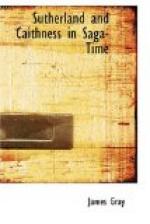They left no male heir, but they left two daughters, Mary and Christian, both minors at their father’s death and probably too young to have been married in August 1263, when, as we shall find, their lands and their half share of the Caithness earldom sadly needed defenders from Norse invaders.
Owing to subsequent additions of territory, it is impossible at the present time to say exactly what all the lands owned by an independent title by Lady Johanna of Strathnaver were, but some guidance towards the further identification of her lands in Caithness is found in the fact that later charters give the names of the lands which her sequel in all her estate, Reginald Chen III, known as “Lord Schein” or “Morar na Shein” held,[28] and that he lived in and hunted from a castle at the exit of the river Thurso from Loch More above Dirlot or Dilred in Strathmore in Halkirk parish, but never owned Brawl, a capital residence of the Caithness earls, but did own to the end of his life “half Caithness,” and acquired South Caithness after 1340 by purchase. Adding to this the facts, indications, and probabilities alluded to in this and preceding chapters as to the position of lands in Caithness variously owned, we are able to venture to come to a general conclusion as to the devolution of the Caithness earldom and lands.
This conclusion is, that what may be termed the shares of the respective lines of Paul and Erlend, the sons of Earl Thorfinn and others, in the Caithness earldom lands probably went respectively between 1231 and 1239 and afterwards in the following manner.
The right to succeed to the share of Paul passed, on his descendant Earl John’s death in 1231, to Earl John’s only child then alive, the nameless hostage daughter, who, according to our theory, had after 1st August 1214 married Magnus, son of Earl Gilchrist of Angus by his second marriage with either Ingibiorg or Elin, both sisters of Harald Ungi, and both older than Ragnhild. But the title of Earl of Caithness and the enjoyment of the whole earldom was on Earl John’s death temporarily conferred, in addition to his title of Earl of Angus, on Malcolm, Earl of Angus, and nephew of Magnus the husband of John’s hostage daughter, as being the head of the Angus family and one of the most powerful earls in Scotland, pending a general settlement of the affairs of Sutherland and Caithness; and Malcolm held his own Earldom of Angus, and, in addition, for the Crown, as Custos, trustee, or administrator pendente lite, held Caithness after 22nd April 1231 and certainly at 7th October 1232, possibly till 3rd July 1236, when the following settlement was made.
Caithness, without Sutherland, was with the title of Earl of Caithness, North and South, confirmed to Earl Magnus II by two grants, the one of North Caithness in right of his wife and the other of South Caithness in right of his mother. The estate of Sutherland was after 10th October 1237 erected into an earldom in the person of William, who was the eldest son of Hugo Freskyn, and was then owner of the estate, this earldom being, as stated in the Diploma of the Orkney Earls, “taken away from Magnus II” in his lifetime, possibly out of South Caithness, by Alexander II.




